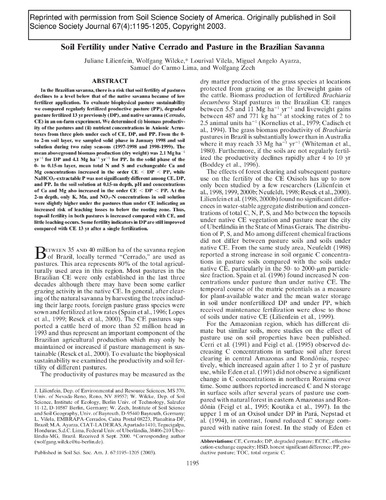Soil fertility under native cerrado and pasture in the Brazilian savanna
In the Brazilian savanna, there is a risk that soil fertility of pastures declines to a level below that of the native savanna because of low fertilizer application. To evaluate biophysical pasture sustainability we compared regularly fertilized productive pasture (PP), degraded pasture fertilized 13 yr previously (DP), and native savanna (Cerrado, CE) in an on-farm experiment. We determined (i) biomass productivity of the pastures and (ii) nutrient concentrations in Anionic Acrustoxes from three plots under each of CE, DP, and PP. From the 0- to 2-m soil layer, we sampled solid phase in January 1998 and soil solution during two rainy seasons (1997-1998 and 1998-1999). The mean aboveground biomass production (dry weight) was 2.1 Mg ha?1 yr?1 for DP and 4.1 Mg ha?1 yr?1 for PP. In the solid phase of the 0- to 0.15-m layer, mean total N and S and exchangeable Ca and Mg concentrations increased in the order CE < DP < PP, while NaHCO3 extractable P was not significantly different among CE, DP, and PP. In the soil solution at 0.15-m depth, pH and concentrations of Ca and Mg also increased in the order CE < DP < PP. At the 2-m depth, only K, Mn, and NO3 N concentrations in soil solution were slightly higher under the pastures than under CE indicating an increased risk of leaching losses to below the rooting zone. Thus, topsoil fertility in both pastures is increased compared with CE, and little leaching occurs. Some fertility indicators in DP are still improved compared with CE 13 yr after a single fertilization.

